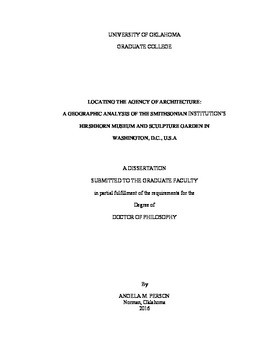| dc.description.abstract | Through my fieldwork and interviews at the Hirshhorn Museum, part of the Smithsonian Institution complex in Washington, D.C., as well as archival research, this study explores the complex relationships between the building, its staff, and its visitors. In this study, I focus on specific ways the building influences affect, memory, and judgments, as well as how people influence the building’s embodiment as a living organism. In Chapter 2, I present the conceptual framework for this study that is grounded in architectural geography literature, which includes understandings of place, affect, and identity. In Chapter 3, I describe my mixed-method, ethnographic approach to this study, including in-depth interviews, photo-elicitation, questionnaires, site observations, Web 2.0 data collection, and archival research. In Chapter 4, I describe the study site, including my rationale for identifying the Hirshhorn Museum and Sculpture Garden as the sole focus of this study. This chapter also situates my own feelings of, in and about the Hirshhorn Museum.
The second section of this dissertation explores intersections of Hirshhorn and individual identities over the course of four chapters. Chapter 5 introduces a tripartite conceptual framework specific to understanding individuals’ feelings of, in, and about buildings. In addition, this chapter introduces the two key questions asked in Section 2:
1. What does discourse about the Hirshhorn’s architecture reveal about its relationship to people in terms of its social, environmental, and emotional affects?
2. What are the implications of these outcomes for the Hirshhorn museum’s own identity?
In answering these questions, the following three chapters attend to the feel of the Hirshhorn, feelings in the Hirshhorn, and feelings about the Hirshhorn.
Chapter 6, “The Feel of the Hirshhorn,” uses the core affect model to document affect, in the form of moods elicited at the Hirshhorn. This chapter maps the moods of staff and visitors onto the four quadrants of the model, finding that both staff and visitors experience moods that rest within each quadrant, but to varying degrees (activated-pleasant; pleasant-deactivated; deactivated-unpleasant; unpleasant-activated). The results show that, in many cases, the Hirshhorn’s built environment provides positive feedback, amplifying feelings of those who work in and visit the place.
Chapter 7, “Feelings in the Hirshhorn,” demonstrates that memories, both dramatic and mundane, influence feelings in the Hirshhorn Museum’s built environment. These memories, which may be formed as a result of interactions with the Hirshhorn, itself, or with other places, differ in the ways they influence feelings in the building for staff and for visitors. For staff, these memories often relate to their daily routines, to memorable art exhibitions that have been installed in the museum, to significant events that occurred in the building, and to their experiences in other museums. For visitors, these memories relate to memories of escaping the bustle of the National Mall, looking at both art and architecture, and experiencing nature.
Chapter 8, “Feelings about the Hirshhorn,” draws on the previous discussions of affect and memory to assemble an understanding of the judgments staff and visitors make in relation to the Hirshhorn’s built environment. I find that staff tend to frame the building more negatively than visitors in their discourse about its aesthetic and function. These judgments—for example, labeling the building as “forbidding” or “welcoming,” “fun” or “boring”—contribute to the sense of place that people understand to exist inside and outside of the Hirshhorn. Broadly speaking, among both staff and visitors there is a sense that the Hirshhorn is an otherworldly place.
Section 3 describes how the Hirshhorn functions as a living building. In Chapter 9, I answer the question: What specific processes allow the Hirshhorn to gain momentum as a living building? Specifically, I find that the Hirshhorn has gained momentum through the processes of political debate and controversy, grand ceremonies, intense media coverage, and its dynamic interactions with staff and visitors, especially staff members’ careful crafting of its spaces over time. As I trace the Hirshhorn’s life, and its growing momentum, I note that the human attachment of bonds to the building demonstrated the integration, co-constitution, and co-dependency between people and things. Through these bonds, the building, itself, becomes “deadening” or “playful,” for example. As these characteristics are transferred to the building, they have also become a part of the Hirshhorn’s identity as a changing, malleable organism.
I close with Section 4, “Conclusions,” in which I describe the implications of this study for the future of both the Hirshhorn Museum, as well as for the sub-discipline of architectural geography. I also posit that “empathetic architecture”— buildings that understand and respect the feelings of their occupants and the communities in which they live—is a valid aim as we consider the future of our built environments. | en_US |
